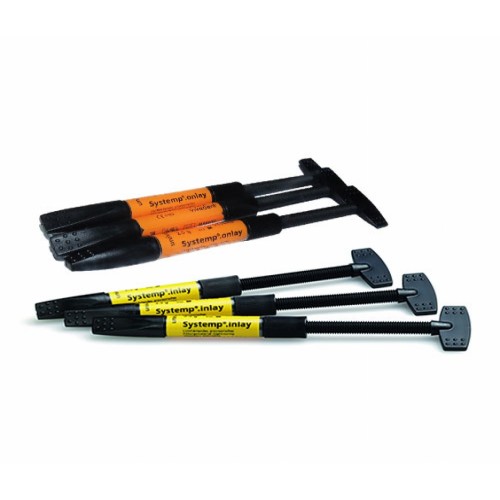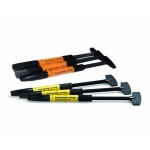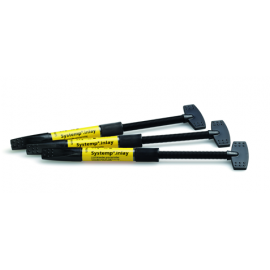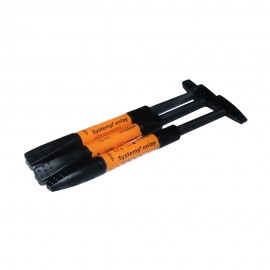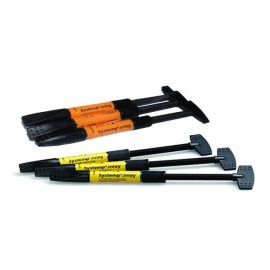Ivoclar Systemp.Onlay & Systemp.Inlay Universal Refills
OverView
Ivoclar Systemp.Onlay & Systemp.Inlay Universal RefillsAvailable Options
For fast ORDERING experience Visit our new site  www.medicabasket.com
www.medicabasket.com
NOTE: Due to volatility in dental market, Price and stock shown here are tentative and needed approval of supplier, Although we update frequently. Our Team will your order soon.
COD is not available now.
Call/ WhatsApp on +91-9313922999 / +91-9810283698

- Information
-
Dental Brands
- 3M Espe
- 3M Unitek
- A.J. Wilcock
- Agfa
- American Orthodontics
- Ammdent
- Anabond
- Angelus
- API Ashoosons
- API Instruments
- Apple Dental
- Being Foshan
- Bestodent
- Bien Air
- BIOLASE
- Blossom
- Bombay Dental
- Capri
- Captain Ortho
- Cerkamed
- Colgate
- Coltene Whaledent
- Confident
- D-Tech
- Danville
- Denext
- Dental Books
- Dental-Avenue
- Dentaurum
- Dentium
- Dentsply
- Desires ortho
- Detax Dental
- Diadent
- Dispodent
- DMG
- DPI
- Durr Dental
- Eighteeth
- Eltee Instruments
- Endoking
- Euronda S.P.A
- Fgm
- Fuji film
- G&H
- GC
- Gen-XT Implant
- Gendex
- Genoray
- Green Guava
- Hahnenkratt
- Heraeus Kulzer
- Horico
- Hu-Friedy
- ICPA
- Ids Denmed
- IMDSL Laser
- Itena
- Ivoclar Vivadent
- J Morita
- Jota
- Kalabhai
- Kavo
- Kerr
- Kodak
- Labomed
- Leone
- Libral
- Life Steriware
- Maarc
- Mani
- Marathon
- MDC
- Medicept
- Meta
- Modern ortho
- Moriz
- Navadha
- Neelkanth
- NeoEndo
- Novabone
- NSK
- Oracura
- Orateek
- Orchestrate O3D Aligner
- Ormco
- Oro
- Ortho Classic
- Ortho Organizers
- Ortho Technology
- Orthocare
- Orthosource
- Premier
- Prevest
- Prima Dental
- Pulpdent
- Pyrax Dental
- Rabbit Force Ortho
- Rejove 32Watts Aligners
- RS Dental Chair
- Ruby Dental
- Ruthinium
- Saeshin
- Samit
- Scheu
- SDI
- Septodont
- Shivam Dental
- Shofu
- SK Surgicals
- Skydent
- SS-White
- Strong
- Sun Medical
- Sure Endo
- Surgiwear
- Tokuyama
- TP Orthodontics
- Unicorn
- Unident
- Unique
- Vatech
- VDW
- VeeCare
- Vita
- Voco
- VRN
- W&H
- Waldent Equipment
- Waldent Instruments
- Waldent Material
- Woodpecker
- Zhermack
- Zoom
- Triodent
- Other brands
- Offers & Combos
- Contact Us
-
Product Category
- Composites & Restoratives
- Dental Education
-
Dental Equipment
- Air-Motor
- Apex Locators
- Autoclaves & Sterilizers
- Dental Air Compressor
- Dental Chair
- Dental Chair Accessories
- Dental Handpiece
- Dental Laser
- Dental Loupes
- Dental Surgery
- Endo Motor
- Handpiece Cartridge
- Implant Motors
- Intraoral Camera
- LED Light Cure
- Micromotors
- Microscope
- Radiology
- Suction Units
- Ultrasonic Scalers
- UV Chamber
- Dental Lab
- Endodontics
- Implantology
- Instruments And Burs
- New Clinic Setup Kits
- Oral Surgery
- Paedodontics
- Periodontics
- Prosthodontics
- Sterilization & COVID-19 Supplies
- General Dentistry
-
Ortho Store
- Arch Wires & Springs
- Bonding Adhesives
- Elastomerics
- Expansion Screws
- Headgear accessories
- Laboratory Products
- Mini TAD Screw
- Molar Bands and Tubes
- Ortho Attachments
- Photographic Accessories
- Weldable Accessories
- Braces or Brackets
- Clear Aligners
- Orthodontic Appliances
- Orthodontic IPR solutions
- Orthodontic Instruments
- Find Your Dentist
- Medica Basket
Your shopping cart is empty!
Ivoclar Systemp.Onlay & Systemp.Inlay Universal Refills
FEATURES:
- Good adhesion to tooth structure; no stickiness to instruments
- Two degrees of elasticity
- Fast curing and high curing depth
- Low polymerization shrinkage
- Minimal marginal gap formation and water absorption
- Two shades; colour stability
- Easy to remove in one piece
- Antimicrobial agents and reduction of undesirable odours
Description
Systemp.inlay and Systemp.onlay are light-curing single-component materials for the fabrication of temporary restorations and do not require the additional use of a temporary cementation material.
Systemp.inlay is particularly recommended for deep inlay preparations with parallel walls as well as for sealing implant screw access canals and for relining prefabricated crowns and bridges. Systemp.inlay is available in two shades, universal and transparent, and in two delivery forms (syringe and Cavifil).
Systemp.onlay achieves a more rigid final cure than System.inlay because it features a higher content of inorganic fillers. The higher strength of Systemp.onlay provides advantages with regard to retention and occlusal and sagittal bracing. Therefore, the material is suited for large preparations.
In addition, Systemp.onlay is suitable for long-term temporaries, flat preparations and preparations with strongly diverging walls. Systemp.onlay is available in two shades, universal and transparent, and in two delivery forms (syringe and Cavifil).COMPOSITION:
Systemp.inlay
The monomer matrix consists of high-molecular dimethacrylates. The fillers are highly dispersed silicon dioxide and copolymers. Triclosan, catalysts and stabilizers are additional ingredients.
Systemp.onlay
The monomer matrix consists of high-molecular dimethacrylates. The fillers are highly dispersed silicon dioxide and copolymers. Triclosan, catalysts and stabilizers are additional ingredients.
INDICATION:
- Systemp.inlay is especially suitable for deep inlay preparations with parallel walls. Systemp.inlay can also be used if small undercuts are present.
- Systemp.inlay is also suitable for relining prefabricated, temporary crowns and bridges made of polycarbonate or methacrylates.
- Systemp.inlay is also suitable for sealing implant screw access openings. –
- Systemp.onlay is especially suitable for large preparations (onlays). If undercuts are present, please note that after curing, Systemp onlay is less elastic than Systemp.inlay, which may complicate removal
Notes
- Systemp.inlay/Systemp.onlay remains well in place in standard inlay preparations. If mechanical retention is minimal, the temporary restoration is cemented with a eugenol-free cement (e.g. Systemp®.link). If Systemp.inlay or Systemp.onlay is applied to undercuts of the proximal region, retention can be improved. In this case, do not place a matrix, but a wooden interdental wedge before applying Systemp.inlay/ Systemp.onlay.
- Systemp.inlay/Systemp.onlay bonds with light-curing base/liner materials because of the similar chemical compositions. If such materials (light-curing glass ionomer cements, composites) are utilized, isolate the base with glycerine gel (Liquid Strip). This prevents the base/lining from being accidentally removed from the cavity together with Systemp.inlay/Systemp.onlay.
- Use silicone finishers (Politip F) or tungsten carbide finishers for grinding and excess removal. Polish with silicone rubber polishers (Politip P). Excess material may also be removed with a scalpel.
- To increase the stability of large cavities, a composite (e.g Heliomolar® or Tetric EvoCeram®) may be applied to the occlusal part of the temporary. Light- cure Systemp.inlay/ Systemp.onlay separately or together with the restorative material.
- Systemp.inlay / Systemp.onlay can be contoured more easily by wetting the instrument with Systemp.desensitizer or an unfilled bonding agent (e.g. Heliobond).
Key Specifications
Storage temperature: 2 – 28 °C (36 – 82 °F)
Technical Specification
Standard - Composition (in weight %) Systemp.inlay Systemp.onlay Polyester urethane dimethacrylate 49.4 29.4 Ethyl triglycol methacrylate --- 7.5 Highly dispersed silicon dioxide, silanized 16.4 19.4 Copolymers 33 42.7 Catalysts, stabilizers and triclosan 1.2 1 Pigments < 0.1 < 0.1 Warning:
Unpolymerized Systemp.inlay/Systemp.onlay should not come in contact with skin, mucous membrane, or eyes. Unpolymerized Systemp.inlay/Systemp.onlay may have a slight irritating effect and may lead to a sensitization against methacrylates. Commercial medical gloves do not provide protection against the sensitizing effect of methacrylates.
Packaging
- 3 x 2.5g Refills
Direction to Use
Preparation appointment
Step 1: Prepare, place base or liner and take impression as usual.
Step 2: Dry prepared teeth; use a matrix if necessary.
Step 3: Clean cavity with water spray
Step 4: Application of Systemp.desensitizer: Apply Systemp.desensitizer and brush the material gently into the dentin for 10 seconds
Step 5: Carefully dry with blown air
Step 6: Place a sufficient quantity of Systemp.inlay or Systemp.onlay into the cavity, using a spatula or another suitable instrument. If you use Cavifils, the material can be applied directly into the cavity by means of the Cavifil Injector. Contour the restoration, leaving minimum excess.
Step 7: Increments of up to 4 mm can be cured with a standard curing light (e.g. bluephase® C5) in 10 seconds, if the light intensity is higher than 500 mW/cm2. The same depth of cure is achieved with LED lights that produce a higher light intensity (e.g. bluephase®) after an exposure time of 10 seconds in the low power mode (LOP).
Step 8: Remove matrix
Step 9: Check occlusion.
Insertion appointment
Step 1: Insert a suitable instrument (e.g. probe/scaler) into the temporary restoration. Remove Systemp.inlay or Systemp.onlay from the cavity
Step 2: Subsequently, clean the cavity (e.g. with rubber cups and cleaning paste).
Step 3: Try in and seat the restoration.



